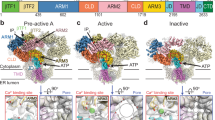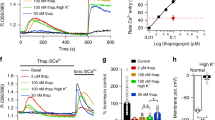Abstract
The versatility of Ca2+ signals derives from their spatio-temporal organization1,2. For Ca2+ signals initiated by inositol-1,4,5-trisphosphate (InsP3), this requires local interactions between InsP3 receptors (InsP3Rs)3,4 mediated by their rapid stimulation and slower inhibition4 by cytosolic Ca2+. This allows hierarchical recruitment of Ca2+ release events as the InsP3 concentration increases5. Single InsP3Rs respond first, then clustered InsP3Rs open together giving a local ‘Ca2+ puff’, and as puffs become more frequent they ignite regenerative Ca2+ waves1,5,6,7,8,9. Using nuclear patch-clamp recording10, here we demonstrate that InsP3Rs are initially randomly distributed with an estimated separation of ∼1 μm. Low concentrations of InsP3 cause InsP3Rs to aggregate rapidly and reversibly into small clusters of about four closely associated InsP3Rs. At resting cytosolic [Ca2+], clustered InsP3Rs open independently, but with lower open probability, shorter open time, and less InsP3 sensitivity than lone InsP3Rs. Increasing cytosolic [Ca2+] reverses the inhibition caused by clustering, InsP3R gating becomes coupled, and the duration of multiple openings is prolonged. Clustering both exposes InsP3Rs to local Ca2+ rises and increases the effects of Ca2+. Dynamic regulation of clustering by InsP3 retunes InsP3R sensitivity to InsP3 and Ca2+, facilitating hierarchical recruitment of the elementary events that underlie all InsP3-evoked Ca2+ signals3,5.
This is a preview of subscription content, access via your institution
Access options
Subscribe to this journal
Receive 51 print issues and online access
$199.00 per year
only $3.90 per issue
Buy this article
- Purchase on Springer Link
- Instant access to full article PDF
Prices may be subject to local taxes which are calculated during checkout




Similar content being viewed by others
References
Berridge, M. J., Lipp, P. & Bootman, M. D. The versatility and universality of calcium signalling. Nature Rev. Mol. Cell Biol. 1, 11–21 (2000)
Rizzuto, R. & Pozzan, T. Microdomains of intracellular Ca2+: molecular determinants and functional consequences. Physiol. Rev. 86, 369–408 (2006)
Marchant, J., Callamaras, N. & Parker, I. Initiation of IP3-mediated Ca2+ waves in Xenopus oocytes. EMBO J. 18, 5285–5299 (1999)
Foskett, J. K., White, C., Cheung, K. H. & Mak, D. O. Inositol trisphosphate receptor Ca2+ release channels. Physiol. Rev. 87, 593–658 (2007)
Bootman, M. D., Berridge, M. J. & Lipp, P. Cooking with calcium: the recipes for composing global signals from elementary events. Cell 91, 367–373 (1997)
Horne, J. H. & Meyer, T. Elementary calcium-release units induced by inositol trisphosphate. Science 276, 1690–1694 (1997)
Marchant, J. S. & Parker, I. Role of elementary Ca2+ puffs in generating repetitive Ca2+ oscillations. EMBO J. 20, 65–76 (2001)
Shuai, J., Rose, H. J. & Parker, I. The number and spatial distribution of IP3 receptors underlying calcium puffs in Xenopus oocytes. Biophys. J. 91, 4033–4044 (2006)
Sneyd, J. & Falcke, M. Models of the inositol trisphosphate receptor. Prog. Biophys. Mol. Biol. 89, 207–245 (2005)
Dellis, O. et al. Ca2+ entry through plasma membrane IP3 receptors. Science 313, 229–233 (2006)
Mak, D.-O. D. & Foskett, J. K. Single-channel kinetics, inactivation, and spatial distribution of inositol trisphosphate (IP3) receptors in Xenopus oocyte nucleus. J. Gen. Physiol. 109, 571–587 (1997)
Ionescu, L. et al. Graded recruitment and inactivation of single InsP3 receptor Ca2+-release channels: implications for quantal Ca2+ release. J. Physiol. (Lond.) 573, 645–662 (2006)
Marx, S. O. et al. Coupled gating between cardiac calcium release channels (ryanodine receptors). Circ. Res. 88, 1151–1158 (2001)
Marx, S. O., Ondrias, K. & Marks, A. R. Coupled gating between individual skeletal muscle Ca2+ release channels (ryanodine receptors). Science 281, 818–821 (1998)
Mak, D.-O. D. & Foskett, J. K. Effects of divalent cations on single-channel conduction properties of Xenopus IP3 receptor. Am. J. Physiol. 275, C179–C188 (1998)
Tateishi, Y. et al. Cluster formation of inositol 1,4,5-trisphosphate receptor requires its transition to open state. J. Biol. Chem. 280, 6816–6822 (2005)
Bourguignon, L. Y., Iida, N. & Jin, H. The involvement of the cytoskeleton in regulating IP3 receptor-mediated internal Ca2+ release in human blood platelets. Cell Biol. Int. 17, 751–758 (1993)
Dargan, S. L. & Parker, I. Buffer kinetics shape the spatiotemporal patterns of IP3-evoked Ca2+ signals. J. Physiol. (Lond.) 553, 775–788 (2003)
Katayama, E. et al. Native structure and arrangement of inositol-1,4,5-trisphosphate receptor molecules in bovine cerebellar Purkinje cells as studied by quick-freeze deep-etch electron microscopy. EMBO J. 15, 4844–4851 (1996)
Yin, C. C., Blayney, L. M. & Lai, F. A. Physical coupling between ryanodine receptor-calcium release channels. J. Mol. Biol. 349, 538–546 (2005)
Fukatsu, K. et al. Lateral diffusion of inositol 1,4,5-trisphosphate receptor type 1 is regulated by actin filaments and 4.1N in neuronal dendrites. J. Biol. Chem. 279, 48976–48982 (2004)
Ferreri-Jacobia, M., Mak, D.-O. D. & Foskett, J. K. Translational mobility of the type 3 inositol 1,4,5-trisphosphate receptor Ca2+ release channel in endoplasmic reticulum membrane. J. Biol. Chem. 280, 3824–3831 (2005)
Sun, X.-P., Callamaras, N., Marchant, J. S. & Parker, I. A continuum of InsP 3-mediated elementary Ca2+ signalling events in Xenopus oocytes. J. Physiol. (Lond.) 509, 67–80 (1998)
Falcke, M. Reading the patterns in living cells—the physics of Ca2+ signaling. Adv. Phys. 53, 255–440 (2004)
Boehning, D., Joseph, S. K., Mak, D.-O. D. & Foskett, J. K. Single-channel recordings of recombinant inositol trisphosphate receptors in mammalian nuclear envelope. Biophys. J. 81, 117–124 (2001)
Prole, D. L., Lima, P. A. & Marrion, N. V. Mechanisms underlying modulation of neuronal KCNQ2/KCNQ3 potassium channels by extracellular protons. J. Gen. Physiol. 122, 775–793 (2003)
Acknowledgements
This work was supported by The Wellcome Trust (C.W.T.), The Biotechnology and Biological Sciences Research Council (C.W.T.), a scholarship from the Jameel Family Trust (T.-U.-R.), and the IRTG ‘Genomics and Systems Biology of Molecular Networks’ of the Deutsche Forschungsgemeinschaft (A.S.). We thank S. Dedos for help with DT40 cells, D. Prole and B. Billups for advice, and T. Kurosaki for providing DT40-KO cells.
Author Contributions T.-U.-R. performed all experiments and, with C.W.T., analysed the data. A.S. and M.F. performed the modelling and contributed to discussions of diffusion. C.W.T. and T.-U.-R. wrote the paper with input from A.S. and M.F. The project was directed by C.W.T.
Author information
Authors and Affiliations
Corresponding author
Supplementary information
Supplementary Information
This file contain Supplementary Methods and Data, a Supplementary Discussion, Supplementary Parameter Tables 1-2, Supplementary References, Supplementary Tables 1-4 and Supplementary Figures 1-9 with Legends. (PDF 1452 kb)
Rights and permissions
About this article
Cite this article
Taufiq-Ur-Rahman, Skupin, A., Falcke, M. et al. Clustering of InsP3 receptors by InsP3 retunes their regulation by InsP3 and Ca2+. Nature 458, 655–659 (2009). https://doi.org/10.1038/nature07763
Received:
Accepted:
Published:
Issue Date:
DOI: https://doi.org/10.1038/nature07763
This article is cited by
-
Ratiometric measurement of MAM Ca2+ dynamics using a modified CalfluxVTN
Nature Communications (2023)
-
Structural titration reveals Ca2+-dependent conformational landscape of the IP3 receptor
Nature Communications (2023)
-
Exploration of inositol 1,4,5-trisphosphate (IP3) regulated dynamics of N-terminal domain of IP3 receptor reveals early phase molecular events during receptor activation
Scientific Reports (2019)
-
Disentangling astroglial physiology with a realistic cell model in silico
Nature Communications (2018)
-
Cryo-EM reveals ligand induced allostery underlying InsP3R channel gating
Cell Research (2018)
Comments
By submitting a comment you agree to abide by our Terms and Community Guidelines. If you find something abusive or that does not comply with our terms or guidelines please flag it as inappropriate.



